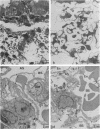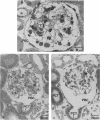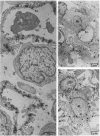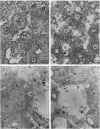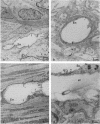Abstract
The presentation of recombinant biologically active 125I-TGF-beta 1 via the bloodstream to potential target cells in mice and rats was evaluated by quantitative light and electron microscope radioautography. Specificity was evaluated by in vivo competition with excess unlabeled TGF-beta 1, and integrity of the ligand at the binding site was demonstrated by trichloroacetic acid precipitation after extraction from tissues. The distribution of radiolabel at 2.5, 15, 30, 45, and 60 min after 125I-TGF-beta 1 injection revealed radiolabel principally over microvasculature endothelium but at times > 2.5 min over endothelial endocytic components indicative of internalization. Nonspecific binding of 125I-TGF-beta 1 to the apex of the proximal convoluted tubule of the kidney indicated it as the likely site of rapid clearance of TGF-beta 1 from the circulation, while a comparison of the binding of 125I-TGF-beta 1 (endothelial) to that of 125I-TGF-beta 1 complexed with alpha 2-macroglobulin-methylamine (liver parenchyma) indicated that clearance of TGF-beta 1 complexed alpha 2-macroglobulin was likely via the hepatic alpha 2-macroglobulin receptor. The endothelial TGF-beta receptors uncovered here are likely involved in the local regulatory mechanism of leukocyte and monocyte adhesion and tissue infiltration regulated by endocrine TGF-beta 1.
Full text
PDF















Images in this article
Selected References
These references are in PubMed. This may not be the complete list of references from this article.
- Akhurst R. J., Lehnert S. A., Faissner A., Duffie E. TGF beta in murine morphogenetic processes: the early embryo and cardiogenesis. Development. 1990 Apr;108(4):645–656. doi: 10.1242/dev.108.4.645. [DOI] [PubMed] [Google Scholar]
- Anscher M. S., Peters W. P., Reisenbichler H., Petros W. P., Jirtle R. L. Transforming growth factor beta as a predictor of liver and lung fibrosis after autologous bone marrow transplantation for advanced breast cancer. N Engl J Med. 1993 Jun 3;328(22):1592–1598. doi: 10.1056/NEJM199306033282203. [DOI] [PubMed] [Google Scholar]
- Armstead W. M., Mirro R., Zuckerman S. L., Shibata M., Leffler C. W. Transforming growth factor-beta attenuates ischemia-induced alterations in cerebrovascular responses. Am J Physiol. 1993 Feb;264(2 Pt 2):H381–H385. doi: 10.1152/ajpheart.1993.264.2.H381. [DOI] [PubMed] [Google Scholar]
- Ausprunk D. H., Folkman J. Migration and proliferation of endothelial cells in preformed and newly formed blood vessels during tumor angiogenesis. Microvasc Res. 1977 Jul;14(1):53–65. doi: 10.1016/0026-2862(77)90141-8. [DOI] [PubMed] [Google Scholar]
- Beck L. S., DeGuzman L., Lee W. P., Xu Y., Siegel M. W., Amento E. P. One systemic administration of transforming growth factor-beta 1 reverses age- or glucocorticoid-impaired wound healing. J Clin Invest. 1993 Dec;92(6):2841–2849. doi: 10.1172/JCI116904. [DOI] [PMC free article] [PubMed] [Google Scholar]
- Bergeron J. J., Levine G., Sikstrom R., O'Shaughnessy D., Kopriwa B., Nadler N. J., Posner B. I. Polypeptide hormone binding sites in vivo: initial localization of 125I-labeled insulin to hepatocyte plasmalemma as visualized by electron microscope radioautography. Proc Natl Acad Sci U S A. 1977 Nov;74(11):5051–5055. doi: 10.1073/pnas.74.11.5051. [DOI] [PMC free article] [PubMed] [Google Scholar]
- Bergeron J. J., Posner B. I. In vivo studies on the initial localization and fate of polypeptide hormone receptors by the technique of quantitative radioautography. J Histochem Cytochem. 1979 Nov;27(11):1512–1513. doi: 10.1177/27.11.229159. [DOI] [PubMed] [Google Scholar]
- Bergeron J. J., Rachubinski R., Searle N., Borts D., Sikstrom R., Posner B. I. Polypeptide hormone receptors in vivo: demonstration of insulin binding to adrenal gland and gastrointestinal epithelium by quantitative radioautography. J Histochem Cytochem. 1980 Aug;28(8):824–835. doi: 10.1177/28.8.6255031. [DOI] [PubMed] [Google Scholar]
- Bergeron J. J., Rachubinski R., Searle N., Borts D., Sikstrom R., Posner B. I. Polypeptide hormone receptors in vivo: demonstration of insulin binding to adrenal gland and gastrointestinal epithelium by quantitative radioautography. J Histochem Cytochem. 1980 Aug;28(8):824–835. doi: 10.1177/28.8.6255031. [DOI] [PubMed] [Google Scholar]
- Bergeron J. J., Resch L., Rachubinski R., Patel B. A., Posner B. I. Effect of colchicine on internalization of prolactin in female rat liver: an in vivo radioautographic study. J Cell Biol. 1983 Mar;96(3):875–886. doi: 10.1083/jcb.96.3.875. [DOI] [PMC free article] [PubMed] [Google Scholar]
- Bergeron J. J., Sikstrom R., Hand A. R., Posner B. I. Binding and uptake of 125I-insulin into rat liver hepatocytes and endothelium. An in vivo radioautographic study. J Cell Biol. 1979 Feb;80(2):427–443. doi: 10.1083/jcb.80.2.427. [DOI] [PMC free article] [PubMed] [Google Scholar]
- Bianchi C., Gutkowska J., Charbonneau C., Ballak M., Anand-Srivastava M. B., De Léan A., Genest J., Cantin M. Internalization and lysosomal association of [125I]angiotensin II in norepinephrine-containing cells of the rat adrenal medulla. Endocrinology. 1986 Oct;119(4):1873–1875. doi: 10.1210/endo-119-4-1873. [DOI] [PubMed] [Google Scholar]
- Bianchi C., Gutkowska J., Thibault G., Garcia R., Genest J., Cantin M. Radioautographic localization of 125I-atrial natriuretic factor (ANF) in rat tissues. Histochemistry. 1985;82(5):441–452. doi: 10.1007/BF02450479. [DOI] [PubMed] [Google Scholar]
- Border W. A., Okuda S., Languino L. R., Sporn M. B., Ruoslahti E. Suppression of experimental glomerulonephritis by antiserum against transforming growth factor beta 1. Nature. 1990 Jul 26;346(6282):371–374. doi: 10.1038/346371a0. [DOI] [PubMed] [Google Scholar]
- Border W. A., Ruoslahti E. Transforming growth factor-beta in disease: the dark side of tissue repair. J Clin Invest. 1992 Jul;90(1):1–7. doi: 10.1172/JCI115821. [DOI] [PMC free article] [PubMed] [Google Scholar]
- Cheifetz S., Bellón T., Calés C., Vera S., Bernabeu C., Massagué J., Letarte M. Endoglin is a component of the transforming growth factor-beta receptor system in human endothelial cells. J Biol Chem. 1992 Sep 25;267(27):19027–19030. [PubMed] [Google Scholar]
- Coffey R. J., Jr, Kost L. J., Lyons R. M., Moses H. L., LaRusso N. F. Hepatic processing of transforming growth factor beta in the rat. Uptake, metabolism, and biliary excretion. J Clin Invest. 1987 Sep;80(3):750–757. doi: 10.1172/JCI113130. [DOI] [PMC free article] [PubMed] [Google Scholar]
- Coimbra T., Wiggins R., Noh J. W., Merritt S., Phan S. H. Transforming growth factor-beta production in anti-glomerular basement membrane disease in the rabbit. Am J Pathol. 1991 Jan;138(1):223–234. [PMC free article] [PubMed] [Google Scholar]
- Di Guglielmo G. M., Baass P. C., Ou W. J., Posner B. I., Bergeron J. J. Compartmentalization of SHC, GRB2 and mSOS, and hyperphosphorylation of Raf-1 by EGF but not insulin in liver parenchyma. EMBO J. 1994 Sep 15;13(18):4269–4277. doi: 10.1002/j.1460-2075.1994.tb06747.x. [DOI] [PMC free article] [PubMed] [Google Scholar]
- Engerman R. L., Pfaffenbach D., Davis M. D. Cell turnover of capillaries. Lab Invest. 1967 Dec;17(6):738–743. [PubMed] [Google Scholar]
- Fertuck H. C., Salpeter M. M. Quantitation of junctional and extrajunctional acetylcholine receptors by electron microscope autoradiography after 125I-alpha-bungarotoxin binding at mouse neuromuscular junctions. J Cell Biol. 1976 Apr;69(1):144–158. doi: 10.1083/jcb.69.1.144. [DOI] [PMC free article] [PubMed] [Google Scholar]
- Fertuck H. C., Salpeter M. M. Sensitivity in electron microscope autoradiography for 125I. J Histochem Cytochem. 1974 Feb;22(2):80–87. doi: 10.1177/22.2.80. [DOI] [PubMed] [Google Scholar]
- Franzén P., ten Dijke P., Ichijo H., Yamashita H., Schulz P., Heldin C. H., Miyazono K. Cloning of a TGF beta type I receptor that forms a heteromeric complex with the TGF beta type II receptor. Cell. 1993 Nov 19;75(4):681–692. doi: 10.1016/0092-8674(93)90489-d. [DOI] [PubMed] [Google Scholar]
- Gamble J. R., Khew-Goodall Y., Vadas M. A. Transforming growth factor-beta inhibits E-selectin expression on human endothelial cells. J Immunol. 1993 May 15;150(10):4494–4503. [PubMed] [Google Scholar]
- Gamble J. R., Vadas M. A. Endothelial adhesiveness for blood neutrophils is inhibited by transforming growth factor-beta. Science. 1988 Oct 7;242(4875):97–99. doi: 10.1126/science.3175638. [DOI] [PubMed] [Google Scholar]
- Gamble J. R., Vadas M. A. Endothelial cell adhesiveness for human T lymphocytes is inhibited by transforming growth factor-beta 1. J Immunol. 1991 Feb 15;146(4):1149–1154. [PubMed] [Google Scholar]
- Ghinea N., Mai T. V., Groyer-Picard M. T., Milgrom E. How protein hormones reach their target cells. Receptor-mediated transcytosis of hCG through endothelial cells. J Cell Biol. 1994 Apr;125(1):87–97. doi: 10.1083/jcb.125.1.87. [DOI] [PMC free article] [PubMed] [Google Scholar]
- Haies D. M., Gil J., Weibel E. R. Morphometric study of rat lung cells. I. Numerical and dimensional characteristics of parenchymal cell population. Am Rev Respir Dis. 1981 May;123(5):533–541. doi: 10.1164/arrd.1981.123.5.533. [DOI] [PubMed] [Google Scholar]
- Heine U., Munoz E. F., Flanders K. C., Ellingsworth L. R., Lam H. Y., Thompson N. L., Roberts A. B., Sporn M. B. Role of transforming growth factor-beta in the development of the mouse embryo. J Cell Biol. 1987 Dec;105(6 Pt 2):2861–2876. doi: 10.1083/jcb.105.6.2861. [DOI] [PMC free article] [PubMed] [Google Scholar]
- Hirai R., Kaji K. Transforming growth factor beta 1-specific binding proteins on human vascular endothelial cells. Exp Cell Res. 1992 Jul;201(1):119–125. doi: 10.1016/0014-4827(92)90355-c. [DOI] [PubMed] [Google Scholar]
- Johns L. D., Flanders K. C., Ranges G. E., Sriram S. Successful treatment of experimental allergic encephalomyelitis with transforming growth factor-beta 1. J Immunol. 1991 Sep 15;147(6):1792–1796. [PubMed] [Google Scholar]
- Karasawa A., Guo J. P., Ma X. L., Lefer A. M. Beneficial effects of transforming growth factor-beta and tissue plasminogen activator in splanchnic artery occlusion and reperfusion in cats. J Cardiovasc Pharmacol. 1991 Jul;18(1):95–105. doi: 10.1097/00005344-199107000-00013. [DOI] [PubMed] [Google Scholar]
- Kopriwa B M. A semiautomatic instrument for the radioautographic coating technique. J Histochem Cytochem. 1966 Dec;14(12):923–928. doi: 10.1177/14.12.923. [DOI] [PubMed] [Google Scholar]
- Kopriwa B. M. A reliable, standardized method for ultrastructural electron microscopic radioautography. Histochemie. 1973 Oct 3;37(1):1–17. doi: 10.1007/BF00306855. [DOI] [PubMed] [Google Scholar]
- Kopriwa B. A comparison of various procedures for fine grain development in electron microscopic radioautography. Histochemistry. 1975 Aug 28;44(3):201–224. doi: 10.1007/BF00491492. [DOI] [PubMed] [Google Scholar]
- Kulkarni A. B., Huh C. G., Becker D., Geiser A., Lyght M., Flanders K. C., Roberts A. B., Sporn M. B., Ward J. M., Karlsson S. Transforming growth factor beta 1 null mutation in mice causes excessive inflammatory response and early death. Proc Natl Acad Sci U S A. 1993 Jan 15;90(2):770–774. doi: 10.1073/pnas.90.2.770. [DOI] [PMC free article] [PubMed] [Google Scholar]
- Kurihara H., Yoshizumi M., Sugiyama T., Takaku F., Yanagisawa M., Masaki T., Hamaoki M., Kato H., Yazaki Y. Transforming growth factor-beta stimulates the expression of endothelin mRNA by vascular endothelial cells. Biochem Biophys Res Commun. 1989 Mar 31;159(3):1435–1440. doi: 10.1016/0006-291x(89)92270-5. [DOI] [PubMed] [Google Scholar]
- Kuruvilla A. P., Shah R., Hochwald G. M., Liggitt H. D., Palladino M. A., Thorbecke G. J. Protective effect of transforming growth factor beta 1 on experimental autoimmune diseases in mice. Proc Natl Acad Sci U S A. 1991 Apr 1;88(7):2918–2921. doi: 10.1073/pnas.88.7.2918. [DOI] [PMC free article] [PubMed] [Google Scholar]
- LaMarre J., Hayes M. A., Wollenberg G. K., Hussaini I., Hall S. W., Gonias S. L. An alpha 2-macroglobulin receptor-dependent mechanism for the plasma clearance of transforming growth factor-beta 1 in mice. J Clin Invest. 1991 Jan;87(1):39–44. doi: 10.1172/JCI114998. [DOI] [PMC free article] [PubMed] [Google Scholar]
- Lefer A. M., Ma X. L., Weyrich A. S., Scalia R. Mechanism of the cardioprotective effect of transforming growth factor beta 1 in feline myocardial ischemia and reperfusion. Proc Natl Acad Sci U S A. 1993 Feb 1;90(3):1018–1022. doi: 10.1073/pnas.90.3.1018. [DOI] [PMC free article] [PubMed] [Google Scholar]
- Lefer A. M. Mechanisms of the protective effects of transforming growth factor-beta in reperfusion injury. Biochem Pharmacol. 1991 Sep 12;42(7):1323–1327. doi: 10.1016/0006-2952(91)90441-7. [DOI] [PubMed] [Google Scholar]
- Lefer A. M., Tsao P., Aoki N., Palladino M. A., Jr Mediation of cardioprotection by transforming growth factor-beta. Science. 1990 Jul 6;249(4964):61–64. doi: 10.1126/science.2164258. [DOI] [PubMed] [Google Scholar]
- Letterio J. J., Geiser A. G., Kulkarni A. B., Roche N. S., Sporn M. B., Roberts A. B. Maternal rescue of transforming growth factor-beta 1 null mice. Science. 1994 Jun 24;264(5167):1936–1938. doi: 10.1126/science.8009224. [DOI] [PubMed] [Google Scholar]
- Lin H. Y., Lodish H. F. Receptors for the TGF-beta superfamily: multiple polypeptides and serine/threonine kinases. Trends Cell Biol. 1993 Jan;3(1):14–19. doi: 10.1016/0962-8924(93)90195-7. [DOI] [PubMed] [Google Scholar]
- Lombardi T., Montesano R., Furie M. B., Silverstein S. C., Orci L. In vitro modulation of endothelial fenestrae: opposing effects of retinoic acid and transforming growth factor beta. J Cell Sci. 1988 Oct;91(Pt 2):313–318. doi: 10.1242/jcs.91.2.313. [DOI] [PubMed] [Google Scholar]
- Lowrance J. H., O'Sullivan F. X., Caver T. E., Waegell W., Gresham H. D. Spontaneous elaboration of transforming growth factor beta suppresses host defense against bacterial infection in autoimmune MRL/lpr mice. J Exp Med. 1994 Nov 1;180(5):1693–1703. doi: 10.1084/jem.180.5.1693. [DOI] [PMC free article] [PubMed] [Google Scholar]
- López-Casillas F., Cheifetz S., Doody J., Andres J. L., Lane W. S., Massagué J. Structure and expression of the membrane proteoglycan betaglycan, a component of the TGF-beta receptor system. Cell. 1991 Nov 15;67(4):785–795. doi: 10.1016/0092-8674(91)90073-8. [DOI] [PubMed] [Google Scholar]
- López-Casillas F., Wrana J. L., Massagué J. Betaglycan presents ligand to the TGF beta signaling receptor. Cell. 1993 Jul 2;73(7):1435–1444. doi: 10.1016/0092-8674(93)90368-z. [DOI] [PubMed] [Google Scholar]
- Madri J. A., Bell L., Merwin J. R. Modulation of vascular cell behavior by transforming growth factors beta. Mol Reprod Dev. 1992 Jun;32(2):121–126. doi: 10.1002/mrd.1080320207. [DOI] [PubMed] [Google Scholar]
- Madri J. A., Kocher O., Merwin J. R., Bell L., Tucker A., Basson C. T. Interactions of vascular cells with transforming growth factors-beta. Ann N Y Acad Sci. 1990;593:243–258. doi: 10.1111/j.1749-6632.1990.tb16116.x. [DOI] [PubMed] [Google Scholar]
- Martineau-Doizé B., Lai W. H., Warshawsky H., Bergeron J. J. In vivo demonstration of cell types in bone that harbor epidermal growth factor receptors. Endocrinology. 1988 Aug;123(2):841–858. doi: 10.1210/endo-123-2-841. [DOI] [PubMed] [Google Scholar]
- Martineau-Doizé B., Warshawsky H., Dickson K., Lai W. H., Bergeron J. J. Localization of epidermal growth factor receptors in cells of the enamel organ of the rat incisor. Dev Biol. 1991 Dec;148(2):590–601. doi: 10.1016/0012-1606(91)90276-9. [DOI] [PubMed] [Google Scholar]
- Massagué J., Attisano L., Wrana J. L. The TGF-beta family and its composite receptors. Trends Cell Biol. 1994 May;4(5):172–178. doi: 10.1016/0962-8924(94)90202-x. [DOI] [PubMed] [Google Scholar]
- Massagué J., Cheifetz S., Boyd F. T., Andres J. L. TGF-beta receptors and TGF-beta binding proteoglycans: recent progress in identifying their functional properties. Ann N Y Acad Sci. 1990;593:59–72. doi: 10.1111/j.1749-6632.1990.tb16100.x. [DOI] [PubMed] [Google Scholar]
- McAllister K. A., Grogg K. M., Johnson D. W., Gallione C. J., Baldwin M. A., Jackson C. E., Helmbold E. A., Markel D. S., McKinnon W. C., Murrell J. Endoglin, a TGF-beta binding protein of endothelial cells, is the gene for hereditary haemorrhagic telangiectasia type 1. Nat Genet. 1994 Dec;8(4):345–351. doi: 10.1038/ng1294-345. [DOI] [PubMed] [Google Scholar]
- McCarron R. M., Wang L., Racke M. K., McFarlin D. E., Spatz M. Cytokine-regulated adhesion between encephalitogenic T lymphocytes and cerebrovascular endothelial cells. J Neuroimmunol. 1993 Mar;43(1-2):23–30. doi: 10.1016/0165-5728(93)90071-6. [DOI] [PubMed] [Google Scholar]
- Merwin J. R., Newman W., Beall L. D., Tucker A., Madri J. Vascular cells respond differentially to transforming growth factors beta 1 and beta 2 in vitro. Am J Pathol. 1991 Jan;138(1):37–51. [PMC free article] [PubMed] [Google Scholar]
- Moses H. L., Yang E. Y., Pietenpol J. A. TGF-beta stimulation and inhibition of cell proliferation: new mechanistic insights. Cell. 1990 Oct 19;63(2):245–247. doi: 10.1016/0092-8674(90)90155-8. [DOI] [PubMed] [Google Scholar]
- Mustoe T. A., Pierce G. F., Thomason A., Gramates P., Sporn M. B., Deuel T. F. Accelerated healing of incisional wounds in rats induced by transforming growth factor-beta. Science. 1987 Sep 11;237(4820):1333–1336. doi: 10.1126/science.2442813. [DOI] [PubMed] [Google Scholar]
- Nadler N. J. Quantitation and resolution in electron microscope radioautography. J Histochem Cytochem. 1979 Nov;27(11):1531–1533. doi: 10.1177/27.11.512340. [DOI] [PubMed] [Google Scholar]
- O'Connor-McCourt M. D., Wakefield L. M. Latent transforming growth factor-beta in serum. A specific complex with alpha 2-macroglobulin. J Biol Chem. 1987 Oct 15;262(29):14090–14099. [PubMed] [Google Scholar]
- Okuda S., Languino L. R., Ruoslahti E., Border W. A. Elevated expression of transforming growth factor-beta and proteoglycan production in experimental glomerulonephritis. Possible role in expansion of the mesangial extracellular matrix. J Clin Invest. 1990 Aug;86(2):453–462. doi: 10.1172/JCI114731. [DOI] [PMC free article] [PubMed] [Google Scholar]
- Okuda S., Nakamura T., Yamamoto T., Ruoslahti E., Border W. A. Dietary protein restriction rapidly reduces transforming growth factor beta 1 expression in experimental glomerulonephritis. Proc Natl Acad Sci U S A. 1991 Nov 1;88(21):9765–9769. doi: 10.1073/pnas.88.21.9765. [DOI] [PMC free article] [PubMed] [Google Scholar]
- Pepper M. S., Vassalli J. D., Orci L., Montesano R. Biphasic effect of transforming growth factor-beta 1 on in vitro angiogenesis. Exp Cell Res. 1993 Feb;204(2):356–363. doi: 10.1006/excr.1993.1043. [DOI] [PubMed] [Google Scholar]
- Pfister H. W., Frei K., Ottnad B., Koedel U., Tomasz A., Fontana A. Transforming growth factor beta 2 inhibits cerebrovascular changes and brain edema formation in the tumor necrosis factor alpha-independent early phase of experimental pneumococcal meningitis. J Exp Med. 1992 Jul 1;176(1):265–268. doi: 10.1084/jem.176.1.265. [DOI] [PMC free article] [PubMed] [Google Scholar]
- Philip A., O'Connor-McCourt M. D. Interaction of transforming growth factor-beta 1 with alpha 2-macroglobulin. Role in transforming growth factor-beta 1 clearance. J Biol Chem. 1991 Nov 25;266(33):22290–22296. [PubMed] [Google Scholar]
- Racke M. K., Dhib-Jalbut S., Cannella B., Albert P. S., Raine C. S., McFarlin D. E. Prevention and treatment of chronic relapsing experimental allergic encephalomyelitis by transforming growth factor-beta 1. J Immunol. 1991 May 1;146(9):3012–3017. [PubMed] [Google Scholar]
- RayChaudhury A., D'Amore P. A. Endothelial cell regulation by transforming growth factor-beta. J Cell Biochem. 1991 Nov;47(3):224–229. doi: 10.1002/jcb.240470307. [DOI] [PubMed] [Google Scholar]
- Roberts A. B., Anzano M. A., Meyers C. A., Wideman J., Blacher R., Pan Y. C., Stein S., Lehrman S. R., Smith J. M., Lamb L. C. Purification and properties of a type beta transforming growth factor from bovine kidney. Biochemistry. 1983 Dec 6;22(25):5692–5698. doi: 10.1021/bi00294a002. [DOI] [PubMed] [Google Scholar]
- Roberts A. B., Sporn M. B., Assoian R. K., Smith J. M., Roche N. S., Wakefield L. M., Heine U. I., Liotta L. A., Falanga V., Kehrl J. H. Transforming growth factor type beta: rapid induction of fibrosis and angiogenesis in vivo and stimulation of collagen formation in vitro. Proc Natl Acad Sci U S A. 1986 Jun;83(12):4167–4171. doi: 10.1073/pnas.83.12.4167. [DOI] [PMC free article] [PubMed] [Google Scholar]
- Roberts A. B., Sporn M. B. Physiological actions and clinical applications of transforming growth factor-beta (TGF-beta). Growth Factors. 1993;8(1):1–9. doi: 10.3109/08977199309029129. [DOI] [PubMed] [Google Scholar]
- Rouleau M. F., Mitchell J., Goltzman D. In vivo distribution of parathyroid hormone receptors in bone: evidence that a predominant osseous target cell is not the mature osteoblast. Endocrinology. 1988 Jul;123(1):187–191. doi: 10.1210/endo-123-1-187. [DOI] [PubMed] [Google Scholar]
- Shull M. M., Ormsby I., Kier A. B., Pawlowski S., Diebold R. J., Yin M., Allen R., Sidman C., Proetzel G., Calvin D. Targeted disruption of the mouse transforming growth factor-beta 1 gene results in multifocal inflammatory disease. Nature. 1992 Oct 22;359(6397):693–699. doi: 10.1038/359693a0. [DOI] [PMC free article] [PubMed] [Google Scholar]
- Spaet T. H., Lejnieks I. Mitotic activity of rabbit blood vessels. Proc Soc Exp Biol Med. 1967 Aug-Sep;125(4):1197–1201. doi: 10.3181/00379727-125-32312. [DOI] [PubMed] [Google Scholar]
- Stitz L., Planz O., Bilzer T., Frei K., Fontana A. Transforming growth factor-beta modulates T cell-mediated encephalitis caused by Borna disease virus. Pathogenic importance of CD8+ cells and suppression of antibody formation. J Immunol. 1991 Nov 15;147(10):3581–3586. [PubMed] [Google Scholar]
- Wahl S. M. The role of transforming growth factor-beta in inflammatory processes. Immunol Res. 1991;10(3-4):249–254. doi: 10.1007/BF02919701. [DOI] [PubMed] [Google Scholar]
- Wahl S. M. Transforming growth factor beta: the good, the bad, and the ugly. J Exp Med. 1994 Nov 1;180(5):1587–1590. doi: 10.1084/jem.180.5.1587. [DOI] [PMC free article] [PubMed] [Google Scholar]
- Wakefield L. M., Smith D. M., Masui T., Harris C. C., Sporn M. B. Distribution and modulation of the cellular receptor for transforming growth factor-beta. J Cell Biol. 1987 Aug;105(2):965–975. doi: 10.1083/jcb.105.2.965. [DOI] [PMC free article] [PubMed] [Google Scholar]
- Wakefield L. M., Winokur T. S., Hollands R. S., Christopherson K., Levinson A. D., Sporn M. B. Recombinant latent transforming growth factor beta 1 has a longer plasma half-life in rats than active transforming growth factor beta 1, and a different tissue distribution. J Clin Invest. 1990 Dec;86(6):1976–1984. doi: 10.1172/JCI114932. [DOI] [PMC free article] [PubMed] [Google Scholar]
- Wang X. F., Lin H. Y., Ng-Eaton E., Downward J., Lodish H. F., Weinberg R. A. Expression cloning and characterization of the TGF-beta type III receptor. Cell. 1991 Nov 15;67(4):797–805. doi: 10.1016/0092-8674(91)90074-9. [DOI] [PubMed] [Google Scholar]
- Warshawsky H., Goltzman D., Rouleau M. F., Bergeron J. J. Direct in vivo demonstration by radioautography of specific binding sites for calcitonin in skeletal and renal tissues of the rat. J Cell Biol. 1980 Jun;85(3):682–694. doi: 10.1083/jcb.85.3.682. [DOI] [PMC free article] [PubMed] [Google Scholar]
- Yamashita H., Ichijo H., Grimsby S., Morén A., ten Dijke P., Miyazono K. Endoglin forms a heteromeric complex with the signaling receptors for transforming growth factor-beta. J Biol Chem. 1994 Jan 21;269(3):1995–2001. [PubMed] [Google Scholar]
- van Houten M., Khan M. N., Khan R. J., Posner B. I. Blood-borne adrenocorticotropin binds specifically to the median eminence-arcuate region of the rat hypothalamus. Endocrinology. 1981 Jun;108(6):2385–2387. doi: 10.1210/endo-108-6-2385. [DOI] [PubMed] [Google Scholar]



